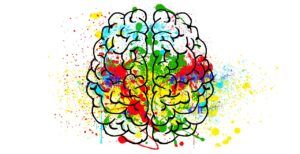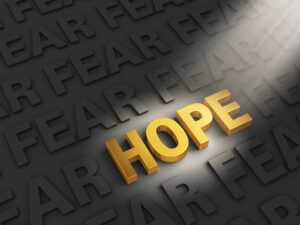Pain transcends sensory perception and is shaped by emotional, cognitive, and behavioral factors. This means that the way we react to pain, and the meaning we ascribe to the pain experience, strongly influences how we cope with pain and our ability to move beyond it.
The fear-avoidance model of pain defines two main attitudes toward pain that a person may have during its onset, or as pain persists (1):
- Absence of fear, which is conducive to confrontation and recovery.
- Pain catastrophizing (PC) stems from the belief that pain can’t be overcome, which leads to fear of re-injury, maladaptive behaviors, and persistent pain.
What is Pain Catastrophizing?
The term ‘catastrophizing’ was coined in 1962 by psychologist Albert Ellis, and refined later by psychiatrist Aaron Beck. PC is a relatively common ‘cognitive distortion’ associated with anxiety and depression. Catastrophizing impairs self-efficacy, social functioning, and is linked to physical disability in both acute injury and chronic pain (2).

Interestingly, the effects of PC may extend beyond the psychological configuration of pain. Evidence suggests that dysregulation of the hypothalamic-pituitary axis and reduced, descending, pain-inhibitory endogenous opioid pathways are two physiological changes associated with PC that increase central sensitization to pain (a phenomenon termed ‘cognitive-emotional sensitization’) (3, 4, 5).
How is Pain Catastrophizing Assessed?
As one of the strongest psychological predictors of pain outcomes, PC needs to be assessed and addressed every time a person presents pain as a main concern to a Physical Therapy session (6, 7).
The Pain Catastrophizing Scale (PCS), is the most widely used method to measure PC (8). The scale is based on 3 domains which include:
- Rumination: e.g. “I can’t stop thinking about how much it hurts.”
- Magnification: e.g. “This pain is everything in my life.”
- Helplessness: e.g. “There is nothing I can do to help my pain.”
The PCS in turn is based on a previous, also widely used tool, known as the Coping Strategies Questionnaire-Catastrophizing sub-scale (CSQ-CAT) (9).
What is the Most Effective Way to Reduce Pain Catastrophizing?
Physical therapists deal with pain conditions on a daily basis, and are likely to encounter patients with PC, which begs the question: what is the most effective way to treat pain in patients who catastrophize?
A recent meta-analysis in the Journal of Pain critically evaluated the results of randomized, controlled trials (RCTs) to find out which interventions are most effective at reducing PC in adults with chronic (non-cancer) pain (10).
These are the study’s main characteristics:
- It included a total of 79 RCTs published between 1988 and 2016, involving 9,914 participants (74% females).
- Only 8 studies specifically targeted PC and also included cohorts with high PC
- The most common measures of PC were the PCS (44 studies) and the CSQ (28 studies)
- The most common pain conditions were spinal pain (most often CLBP or neck pain; 24 studies), mixed pain cohorts (19 studies), and fibromyalgia (17 studies)
- 17 types of intervention were identified, that contained:
- Mostly psychological content (48 studies)
- Mostly physical treatments, such as exercise, acupuncture, or manual therapy (7 studies)
- Multimodal interventions (a combination of physical and psychological content; 22 studies)
- Purely pharmacological treatments (2 studies)
- Most interventions were delivered face-to-face, with 34 studies using a group format and 24 conducted individually. 21 studies were predominantly self-administered using some form of media (internet, telephone, etc.)
- The duration of interventions varied considerably, ranging from 1 day to 28 weeks (median = 8 hrs)
- The most common interventions were CBT (28 studies) and multimodal interventions (20 studies), all of which contained a CBT component.
The meta-analysis revealed that several interventions work moderately well in reducing PC, though Cognitive Behavior Therapy (CBT), Acceptance and Commitment Therapy (ACT), and multimodal treatment (CBT plus Physical Therapy), had the best supporting evidence. The best results were obtained with multimodal treatments combining CBT and exercise.
“When studies targeting people with high PC were assessed, Multimodal Treatment (CBT+PT) showed the strongest effects.”
3 Ways to Target Pain Catastrophizing
#1 Cognitive Behavior Therapy
In 1955, Ellis introduced Rational Emotive Behavior Therapy (REBT). Years later, A. Beck defined the general framework for CBT. At the root of these therapies is the notion that human emotions and behavior are mainly determined by ideas, thoughts, beliefs, and attitudes, rather than events. Therefore, identifying and changing maladaptive cognitions, emotions, and behaviors is a critical step to better managing and eventually overcoming pain. CBT is widely used to treat functional disabilities related to pain, and recent evidence indicates that CBT is one of the most effective ways to treat PC in chronic pain patients (11),

Want to know more about CBT? Check out my blog: COGNITIVE-BEHAVIORAL THERAPY SKILLS FOR MODERN PAIN PRACTITIONERS
When studies targeting people with high PC were assessed, Multimodal Treatment (CBT+PT) showed the strongest effects. Share on X#2 Acceptance and Commitment Therapy
While CBT focuses on recognizing, evaluating, and modifying unhelpful pain-related thoughts, emotions, and behaviors, Acceptance and Commitment Therapy promotes awareness and nonjudgmental acceptance of chronic pain while identifying and committing to goals supporting highly regarded life values (12). In the context of pain, Acceptance and Commitment Therapy is based on the premise that while pain hurts, it is the struggle with pain that causes suffering (13).
For expert discussions on CBT and ACT for chronic pain in Physical Therapy practice, check out these podcasts:
Cognitive And Mindfulness-Based Pain Care with Dr. Beverly E. Thorn, PhD
How To Avoid The Trap Of Negative Thinking Using ACT with Dr Kevin Vowles
#3 Multimodal Treatment (CBT + Physical Therapy)
Every multimodal intervention included CBT, which was the most common psychological intervention across studies. When combined with exercise, PC reduction was greater than that obtained through ACT or CBT alone. Moreover, CBT-supplemented exercise had the largest effect on high baseline subjects in studies that focused primarily on PC treatment by use of active controls. Since exercise does not directly target negative thinking associated with PC, the reasons it had a beneficial impact on PC are not immediately apparent. The authors propose several possible explanations for this (10):
- Exercising without catastrophic outcomes could contribute to cognitive restructuring by providing disconfirmatory evidence.
- Exercise may help to shift attention away from rumination due to its attentional demands and mood effects.
- The use of exercise as a self-management tool could increase self-efficacy and thereby reduce helplessness.
- Given the evidence of a bidirectional relationship between pain intensity and PC, the modulation of descending inhibitory control mechanisms associated with paced exercise may indirectly reduce PC via pain reduction.
As the authors point out, yet another possibility is that multimodal treatments are more likely to match at least one treatment component to a patient strength or deficit (14).
Dr. Tatta’s simple and effective pain assessment tools. Quickly and easily assess pain so you can develop actionable solutions in less time.
From Fear to Hope: A Physical Therapist’s role
The evidence shows that several approaches may help reduce PC in chronic pain patients, and that among these, CBT plus exercise may work best for most people. Currently, psychologically informed care for pain management is taking the spotlight, though exercise will always deliver a wide range of benefits in both physical and mental health. For this reason, the importance of exercise prescription cannot be overestimated.

Physical Therapy patients come from all walks of life and many different lifestyles. Two key aspects that physical therapists should evaluate are: whether preferred treatment, or particular components therein, will be a good match to his/her patient profile (14); and his/her own confidence and competence in delivering these therapies.
On the other hand, as awareness of the influence of psychosocial factors in pain coping and management continues to grow, the importance of empathy and compassion in PT-client interactions should be appreciated. It’s not just the message that matters, but the messenger’s delivery of it, and most importantly, the mutual trust that can be cultivated through genuine and open exchange.
How do you evaluate and treat pain catastrophizing in your practice?
Please leave us a comment below, and visit us on Facebook!
REFERENCES:
1- Vlaeyen, J. W., Crombez, G., & Linton, S. J. (2016). The fear-avoidance model of pain. Pain, 157(8), 1588-1589.
2- Leung, L. (2012). Pain catastrophizing: an updated review. Indian journal of psychological medicine, 34(3), 204.
3- Edwards, R. R., Kronfli, T., Haythornthwaite, J. A., Smith, M. T., McGuire, L., & Page, G. G. (2008). Association of catastrophizing with interleukin-6 responses to acute pain. Pain, 140(1), 135-144.
4- Goodin, B. R., McGuire, L., Allshouse, M., Stapleton, L., Haythornthwaite, J. A., Burns, N., … & Edwards, R. R. (2009). Associations between catastrophizing and endogenous pain-inhibitory processes: sex differences. The Journal of Pain, 10(2), 180-190.
5- Huysmans, E., Ickmans, K., Van Dyck, D., Nijs, J., Gidron, Y., Roussel, N., … & De Kooning, M. (2018). Association between symptoms of central sensitization and cognitive behavioral factors in people with chronic nonspecific low back pain: A cross-sectional study. Journal of manipulative and physiological therapeutics, 41(2), 92-101.
6- Bergbom, S., Boersma, K., Overmeer, T., & Linton, S. J. (2011). Relationship among pain catastrophizing, depressed mood, and outcomes across physical therapy treatments. Physical therapy, 91(5), 754-764.
7- Smeets, R. J., Vlaeyen, J. W., Kester, A. D., & Knottnerus, J. A. (2006). Reduction of pain catastrophizing mediates the outcome of both physical and cognitive-behavioral treatment in chronic low back pain. The Journal of Pain, 7(4), 261-271.
8- Sullivan, M. J., Bishop, S. R., & Pivik, J. (1995). The pain catastrophizing scale: development and validation. Psychological assessment, 7(4), 524.
9- Hirsh, A. T., George, S. Z., Riley III, J. L., & Robinson, M. E. (2007). An evaluation of the measurement of pain catastrophizing by the coping strategies questionnaire. European Journal of Pain, 11(1), 75-75.
10- Schütze, R., Rees, C., Smith, A., Slater, H., Campbell, J. M., & O’Sullivan, P. (2017). How can we best reduce pain catastrophizing in adults with chronic non-cancer pain? A systematic review and meta-analysis. The Journal of Pain.
11- Williams, A. C., Eccleston, C., & Morley, S. (2012). Psychological therapies for the management of chronic pain (excluding headache) in adults.
12- Hooten, W. M. (2016, July). Chronic pain and mental health disorders: shared neural mechanisms, epidemiology, and treatment. In Mayo Clinic Proceedings (Vol. 91, No. 7, pp. 955-970). Elsevier.
13- Dahl, J., & Lundgren, T. (2006). Acceptance and commitment therapy (ACT) in the treatment of chronic pain. Mindfulness-based treatment approaches: Clinician’s guide to evidence base and applications, 285-306.
14- Day, M. A., Ehde, D. M., & Jensen, M. P. (2015). Psychosocial pain management moderation: The limit, activate, and enhance model. The Journal of Pain, 16(10), 947-960.
Ellis A. Reason and emotion in psychotherapy. New York: L. Stuart; 1962. p. 442.
Fisher, E., Heathcote, L. C., Eccleston, C., Simons, L. E., & Palermo, T. M. (2017). Assessment of pain anxiety, pain catastrophizing, and fear of pain in children and adolescents with chronic pain: A systematic review and meta-analysis. Journal of pediatric psychology, 43(3), 314-325.



